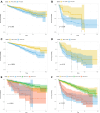Head and body/tail pancreatic neuroendocrine tumors have different biological characteristics and clinical outcomes
- PMID: 32601815
- PMCID: PMC11804438
- DOI: 10.1007/s00432-020-03303-w
Head and body/tail pancreatic neuroendocrine tumors have different biological characteristics and clinical outcomes
Abstract
Purpose: The incidence of pancreatic neuroendocrine tumors (pNETs) has continued to increase, but for pNETs, there is still no distinction between treatments based on anatomical location. We aim to determine whether NETs located at the head and body/tail of the pancreas are different.
Patients and methods: Within the Surveillance, Epidemiology, and End Results database (2004-2016), we focused on pNETs patients with comprehensive information. The patients were divided into two groups based on tumors' location. We compared the characteristics of the two groups and assessed the risk factors for lymphatic metastasis. Survival analysis was performed based on the biological characteristics of the tumor.
Results: In all 3011 patients, pNETs were more common in the body/tail (62.94%) than in the head (37.06%) of the pancreas. The risk factors for lymph node metastasis in the two groups were different. Nonmetastatic, low-grade pancreatic body/tail NETs had the best prognosis (p < 0.001). For low-grade tumors (G1-G2), lymphatic metastasis did not significantly affect the prognosis of patients with pancreatic head NETs (p = 0.098) but affected the overall survival of patients with pancreatic body/tail NETs (p < 0.001). The tumors at the pancreatic head were larger (p = 0.001), more likely to have positive lymph nodes (p < 0.001) and more prone to locally advanced and distant invasion (p < 0.001). The prognosis of pancreatic head NETs 21-40 mm was worse than that of body/tail pNETs (p < 0.001). For non-functional NETs, the overall survival of pancreatic body/tail tumors was better (p < 0.001).
Conclusion: The pancreatic head and pancreatic body/tail NETs have different biological characteristics and clinical outcomes and they should be treated differently.
Keywords: Clinical outcomes; Pancreatic neuroendocrine tumors; Prognosis; Tumor biological characteristics.
Conflict of interest statement
None.
Figures






References
-
- Cherenfant J, Stocker SJ, Gage MK, Du H, Thurow TA, Odeleye M, Schimpke SW, Kaul KL, Hall CR, Lamzabi I, Gattuso P, Winchester DJ, Marsh RW, Roggin KK, Bentrem DJ, Baker MS, Prinz RA, Talamonti MS (2013) Predicting aggressive behavior in nonfunctioning pancreatic neuroendocrine tumors. Surgery 154(785–791):791–793 - PubMed
-
- Chivukula SV, Tierney JF, Hertl M, Poirier J, Keutgen XM (2020) Operative resection in early stage pancreatic neuroendocrine tumors in the United States: are we over- or undertreating patients? Surgery 167:180–186 - PubMed
-
- DePalo DK, Lee RM, Lopez-Aguiar AG, Gamboa AC, Rocha F, Poultsides G, Dillhoff M, Fields RC, Idrees K, Nathan H, Abbott D, Maithel SK, Russell MC (2019) Interaction of race and pathology for neuroendocrine tumors: epidemiology, natural history, or racial disparity? J Surg Oncol 120:919–925 - PMC - PubMed
MeSH terms
Grants and funding
LinkOut - more resources
Full Text Sources
Medical

